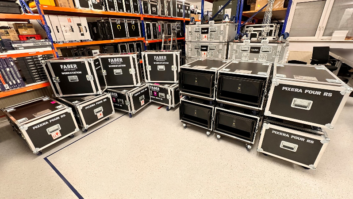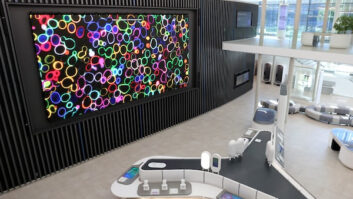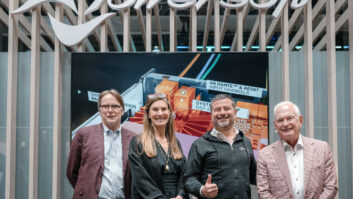At last month’s CEDIA Home Technology Event, IE Residential and AWE Europe convened a special industry roundtable to explore media servers and examine the role of this technology in custom installation projects. Chaired by IE Residential editor Paddy Baker, the roundtable gathered together key figures from the industry.
On the panel at the roundtable were:
• Robin Courtenay from SMC
• Tony Harper from T&T Automation
• Justin Wells from Interactive Homes
• Simon Clarke from Clarke Infinity
• Jon Alway from media server manufacturer DF Solutions and
• Stuart Tickle from residential CI distributor AWE Europe (exclusive distributor of the DF Solutions range).
Here’s what they had to say.
How integral are media servers to your current projects?
Robin Courtenay, SMC: First, I think it’s valid to ask the question: what actually is a media server these days? The market began with audio servers, then came audio and video servers, and what we’re seeing now are a number of devices that dock with an iPod, where the iPod is becoming the hard disc part of the system, offering convenience to the user and compatibility with iTunes which clients are very familiar with.
Products on the market today range from very affordable and sophisticated technologies, like Apple TV, right through to the robust and expensive Kaleidescape system. Our experience tells us that if a job has AV, then it will feature a media server, and audio server type products are the most popular.
Justin Wells, Interactive Homes: They are a central point within the AV package we provide. Private clients like media servers, although in our developer work there is often resistance over pricing. Interestingly, including a media server can be helpful on a project because it changes the network infrastructure for the better, eliminating the need for a certain amount of switching and having to distribute everything over a video matrix system.
Tony Harper, T&T Automation: Audio is the foundation of our clients’ interest in media servers. It’s more repeatable, takes less sensory input to enjoy and is the most compelling reason to buy the technology. There’s also a completely different legal wrap around music than video. Generally speaking, audio is available and video is not.
What are you and your clients looking for from a media server product?
Harper: We need content aggregators. Content delivery, whether it’s centralised or decentralised is pretty much a given, but it is access to content that we and our clients are looking for.
Courtenay: Agreed. Media content is available now from so many different places, and there’s a distinct shift from locally stored media, which is still important, to cloud based content delivered through streaming.
Stuart Tickle, AWE Europe: Having portable devices, like the iPod, has created an expectation of convenience but today in CI there’s a fundamental requirement to provide bespoke devices that work reliably with an element of maintenance, predictability and support which mass market products cannot offer. We are also dealing with different generations; older people have archives of CDs and DVDs whereas the younger generation, the consumers of tomorrow, have never even bought a CD. Media server suppliers have to be capable of adapting to these different demands.
Jon Alway, DF Solutions: We recognise the need to be able to deliver a mixture of the user’s own content and cloud based services – CDs, DVDs, network stored audio, photos and videos, internet radio, streaming services, video clips from YouTube and more. The media server needs to serve everything from the cheap clip to the high quality Blu-ray experience. And quickly.
Courtenay: Alongside access to content, our customers demand convenience and reliability, and importantly a unified user experience. Content should easily and instantly play and behave in a uniform way. The media server experience must be easy to use and super reliable. Bombproof, in fact.
What about media server pricing – is that a factor?
Alway: The media server product category is now clearly defined, with tiered levels and a clear choice of options at those levels. For installers the challenge is to match the right product, its features and benefits, to what their customer wants and can afford.
Simon Clarke, Clarke Infinity: It’s important to do what’s right for the client, and advise them accordingly. Sometimes, the right advice where budget is an issue is to spec the more value for money media server brands on the market, like DF Solutions.
Harper: The consumer grade in the middle is pile it high sell it cheap. That’s not the market for expensive media servers. At the hi-end, wealthy clients are driven by elitism. They want what others don’t have. It’s human nature and it will always be there.
Tickle: Different price points work at different levels of the market. Increasingly, media servers are not about the hardware and its storage which is readily available and inexpensive, but the software that delivers the great user experience and enables the integration into the CI home. That’s the tough part.
Wells: If the client doesn’t want to spend £20,000 on a hi-end media server, then as an installer you have to ask the question whether going down to a lower budget product might get you into a situation you want to avoid, having to deal with reliability and service issues down the line.
Tickle: That’s why it’s important for a supplier to offer the support and training to help you through the nuances of the technology and make the most of the product features. For example, we can teach you how to dial in remotely to provide maintenance and fix problems without having to go to site. That’s how it works with AWE and DF Solutions anyway!
What is the role of the broadband provider in downloading and streaming content?
Courtenay: To download a standard definition movie can take anything from 30 minutes to two hours. Streaming services are generally poor at peak evening times. We want a consistent, fair service. Some of our clients are prepared to pay the provider a price premium for a higher contention ratio. Convenience is king.
Harper: The current BT infrastructure is not good enough. The integral contention ratio and capacity is the problem. It needs upgrading and someone has to pay for it.
What about the legal issues?
Tickle: We live in a world of consumers who want it now. However, it’s absolutely right that the copyright owner should be paid and recognised for what they produce in audio and video. It’s up to the industry to respond to that demand and put the legal framework in place to enable it. What’s wrong with copying the DVD that you own and storing that content on a media server for you and your family to enjoy in any room around the house?
Courtenay: What an Englishman does in the privacy of his or her own home is to an extent up to them. Our customers do care about the legal issues. They want to behave honestly. Playing content from a media server in a public place, or a hotel, hospital, oil rig, etc is totally different and should be licensed accordingly.
Wells: Price will be a factor here too. The price for renting an online movie will ultimately fall to such an extent that the majority of people won’t actually bother to rip it. That tipping point has already been reached in audio. One of the other thoughts coming out of the US is local licensing. If I went out and bought my copy of Avatar at £12.99, then I should be allowed a local license to archive it.
Harper: As media servers move towards being content aggregators and providers, there are plenty of obstacles from the content owners to overcome. It’s not that straightforward but I’m sure we’ll be there within the next two or three years. As far as legality is concerned, it’s every client to his own, so long as the installer the documentation in place to exonerate their own position.
Where is the market heading?
Courtenay: Our job will be aggregating our clients’ content and managing their experience, not selling hardware in the future. We are a service industry. We sell on trust and will make our money based on the level of service that we provide. In years to come, the media server as a concept will exist as something that brings you content, but where will that content actually sit? The answer is it will be out there somewhere. Wherever it is, you can be sure the client experience will be a highly personalised one.
Harper: The margin on media server and other hardware is eroding fast. The future is the software and layer of middleware that will bring clients access to content. Ultimately, the client doesn’t care where that content will come from. For installers, if you don’t base your business model on service, then you’re history. We are the glue in the middle of many projects, the people who clients look to when they want to solve their problems.
Clarke: We are entering a decade where we will only survive if our business is built on trust. We need to give the client what’s right for their environment and not what makes us the most money. My guess is that the trend will be towards having a virtual assistant that will be able to play your favourite movie or music and search for content from a variety of sources.
For the security conscious that may include a local server. Your virtual assistant will have knowledge of your preferred room temperature and will know when to interrupt you with information about arrival of guests and which friends are on-line gaming. While you enjoy your favourite movie they will find the best price for flights for you, keep an eye on traffic reports and update your twitter for you too.
Tickle: The CI industry is resilient and will adapt to the future. There is still a big market out there for reliable, CI friendly media servers that can deliver a variety of content in a user friendly way. The CI industry will be able implement this demand that’s always there to stay ahead of what the mass market can offer.







